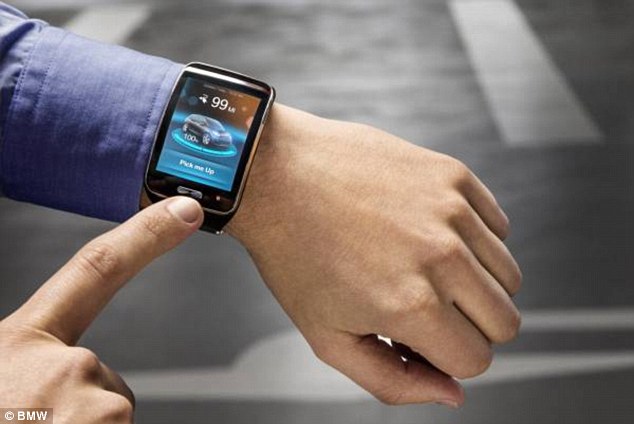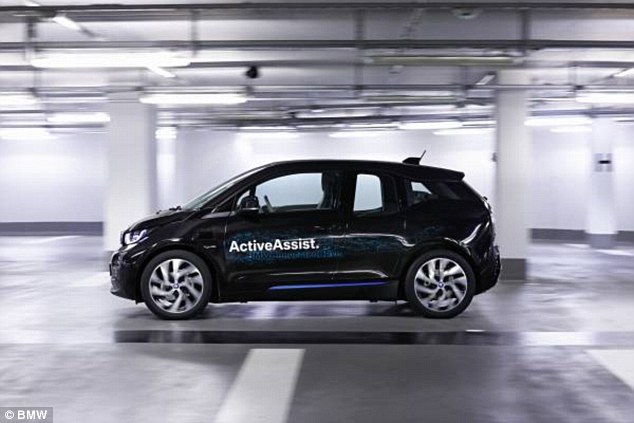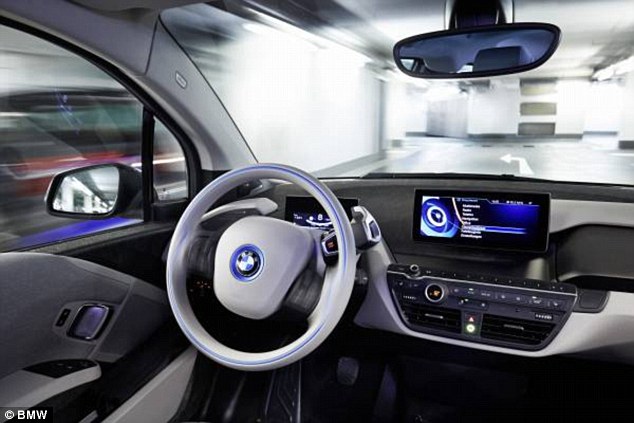Forget valets - BMW's automated car parks ITSELF when you speak into your smartwatch
- Munich-based BMW has unveiled technology that can park your car
- It uses four lasers on the car to create a virtual map of the car park
- When arriving the driver can simply instruct the car to go park
- When they come back they speak into the watch again to be picked up
- BMW says it is more precise than existing GPS systems
- They have also revealed 360-degree collision avoidance
There’s nothing worse than forgetting where you’ve parked your car in a multi-storey car park.
But soon you won’t even need to climb the stairs to another floor, as BMW has announced a new feature that can park itself and return to you at the touch of a button.
When a voice command is spoken into a smartwatch, the car will leave its space and drive to the exit, calculating the time it will take so that it arrives just as you get there.

Munich-based BMW has unveiled technology that can park your car. It uses four lasers on the car to create a virtual map of the car park. When arriving the driver instructs the car to go park using a smartwatch (shown)
The new technology, known as the Remote Valet Parking Assistant, is being tested on Munich-based BMW’s i3 vehicle.
Instead of GPS, the technology uses four laser scanners on the car, which create a virtual map of the building, to navigate.
When arriving at the car park, the driver need only get out of the vehicle and activate the feature.
The car will then recognise the structural features of the car park, and ‘equally reliably steers round any obstaces that appear unexpectedly - such as incorrectly parked vehicles,’ according to BMW.
According to its makers, it can even look for a parking spot and recognise which ones are empty. The company hasn’t said what would happen if it doesn’t manage to find one, though, such in a busy car park in London or New York.
The technology is being developed alongside other new features such as 360-degree collision avoidance.
This uses the laser scanners to record the environment and identify obstacles such as columns or walls.

The car will automatically find an empty space and lock itself there (shown). To park it doesn't require any additional infrastructure, so existing structures can be used
If the system detects a collision is imminent, it brakes automatically.
BMW also says the use of lasers over GPS is better, as the latter is ‘not at all precise’ in multi-storey car parks.
The system does not require specially designed car parks; it can work in any pre-existing car park without any additional infrastructure.
However, the company has not yet announced when the feature will be available in any of its cars on sale.

When the driver comes back they speak into the watch again to be picked up (shown). BMW says it is more precise than existing GPS systems. They have also revealed a 360-degree collision avoidance system
Most watched News videos
- TikTokers provide inside look at the line for Bonnie Blue's marathon
- Man declares 'mission accomplished' as he gives Bonnie Blue a cap
- Incredible moment homeless mum dog carries dying pup to vets
- Moment Russian influencer throws two-month-old son into a snowdrift
- Shocking moment transgender girl is set upon by masked teenage mob
- Shocking moment woman hits a police officer and leaves her in tears
- Fiery debris falls over Turks and Caicos Islands after SpaceX explosion
- Woman is arrested for bad behavior at Ohio car wash
- Moment 'trans hate mob' ringleader Summer Betts-Ramsey is arrested
- Shocking moment transgender girl is set upon by masked teenage mob
- Brazilian martial artist tackles handbag thief to the ground
- California grandma remains positive despite losing home in fires














































































































































































